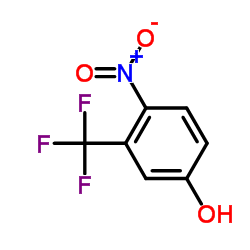Lamprecid

Lamprecid structure
|
Common Name | Lamprecid | ||
|---|---|---|---|---|
| CAS Number | 88-30-2 | Molecular Weight | 207.107 | |
| Density | 1.6±0.1 g/cm3 | Boiling Point | 307.5±42.0 °C at 760 mmHg | |
| Molecular Formula | C7H4F3NO3 | Melting Point | 76-79 °C(lit.) | |
| MSDS | Chinese USA | Flash Point | 139.8±27.9 °C | |
| Symbol |

GHS07 |
Signal Word | Warning | |
|
Effect of fenofibrate on retinal neurodegeneration in an experimental model of type 2 diabetes.
Acta Diabetol. 52(1) , 113-22, (2015) There is now consistent evidence from two major clinical trials (the Fenofibrate Intervention and Event Lowering in Diabetes and the Action to Control Cardiovascular Risk in Diabetes Eye) that fenofibrate arrests the progression of diabetic retinopathy in typ... |
|
|
An RNA binding protein promotes axonal integrity in peripheral neurons by destabilizing REST.
J. Neurosci. 34(50) , 16650-61, (2014) The RE1 Silencing Transcription Factor (REST) acts as a governor of the mature neuronal phenotype by repressing a large consortium of neuronal genes in non-neuronal cells. In the developing nervous system, REST is present in progenitors and downregulated at t... |
|
|
Stiffening hydrogels for investigating the dynamics of hepatic stellate cell mechanotransduction during myofibroblast activation.
Sci. Rep. 6 , 21387, (2016) Tissue fibrosis contributes to nearly half of all deaths in the developed world and is characterized by progressive matrix stiffening. Despite this, nearly all in vitro disease models are mechanically static. Here, we used visible light-mediated stiffening hy... |
|
|
Coupling primary and stem cell-derived cardiomyocytes in an in vitro model of cardiac cell therapy.
J. Cell Biol. 212 , 389-97, (2016) The efficacy of cardiac cell therapy depends on the integration of existing and newly formed cardiomyocytes. Here, we developed a minimal in vitro model of this interface by engineering two cell microtissues (μtissues) containing mouse cardiomyocytes, represe... |
|
|
A quantitative assay for reductive metabolism of a pesticide in fish using electrochemistry coupled with liquid chromatography tandem mass spectrometry.
Environ. Sci. Technol. 49(7) , 4450-7, (2015) This is the first study to use electrochemistry to generate a nitro reduction metabolite as a standard for a liquid chromatography-mass spectrometry-based quantitative assay. This approach is further used to quantify 3-trifluoromethyl-4-nitrophenol (TFM) redu... |
|
|
Whole-body distribution an Malpighian tubule transport of 2',5-dichloro-4'-nitrosalicylanilide (Bayer 73) and 3-trifluoromethyl-4-nitrophenol in larvae of the aquatic midge Chironomus tentans.
Xenobiotica 10(4) , 257-63, (1980) 1. Residues of the lampricides 14C-Bayer 73 (2',5-dichloro-4'-nitrosalicylanilide) and 14C-TFM (3-trifluoromethyl-4-nitrophenol) were absorbed from aqueous sublethal concn. by aquatic larvae of the midge Chironomus tentans. 2. Toxicant residues were widely di... |
|
|
Saturation of subcutaneous adipose tissue expansion and accumulation of ectopic fat associated with metabolic dysfunction during late and post-pubertal growth.
Int. J. Obes. 40 , 601-6, (2016) Puberty is a period defined by large changes in adipose tissue accumulation and distribution; however, longitudinal patterns of ectopic fat development have not been shown. We have previously shown significant declines in beta-cell function (BCF) across puber... |
|
|
Change in weight and body composition in obese subjects following a hypocaloric diet plus different training programs or physical activity recommendations.
J. Appl. Physiol. 118(8) , 1006-13, (2015) The aim of the present study was to compare the effects of different physical activity programs, in combination with a hypocaloric diet, on anthropometric variables and body composition in obese subjects. Ninety-six obese (men: n = 48; women: n = 48; age rang... |
|
|
Evaluation of the short term 12 hour toxicity of 3-trifluoromethyl-4-nitrophenol (TFM) to multiple life stages of Venustaconcha ellipsiformis and Epioblasma triquetra and its host fish (Percina caprodes).
Environ. Toxicol. Chem. 34 , 1634-41, (2015) The present study evaluated the risk of 12-h exposures of the lampricide 3-trifluoromethyl-4-nitrophenol (TFM) to multiple life stages of the federally endangered snuffbox (Epioblasma triquetra) and its primary host fish the common logperch (Percina caprodes)... |
|
|
The lampricide 3-trifluoromethyl-4-nitrophenol (TFM) uncouples mitochondrial oxidative phosphorylation in both sea lamprey (Petromyzon marinus) and TFM-tolerant rainbow trout (Oncorhynchus mykiss).
Comp. Biochem. Physiol. C. Toxicol. Pharmacol. 153(3) , 342-9, (2011) The toxicity of 3-trifluoromethyl-4-nitrophenol (TFM) appears to be due to a mismatch between ATP supply and demand in lamprey, depleting glycogen stores and starving the nervous system of ATP. The cause of this TFM-induced ATP deficit is unclear. One possibi... |